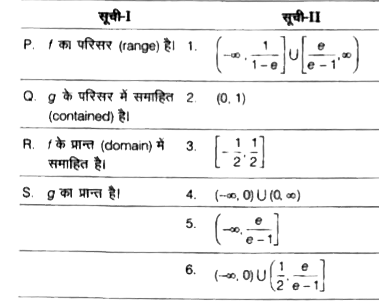समाकलन ∫1/201+√3(((x+1)2)(1−x6))14dx का मान है
The correct Answer is:B
Step by step video, text & image solution for समाकलन int_(0)^(1//2)(1+sqrt3)/(((x+1)^2)(1-x^6))^(1/4)dx का मान है by Maths experts to help you in doubts & scoring excellent marks in Class 12 exams.
Updated on:21/07/2023Topper's Solved these Questions
- JEE ADVANCED सोल्वड पेपर्स 2018 BOOK - JEE Main & Advanced (Hindi Medium)CHAPTER - JEE ADVANCED सोल्वड पेपर्स 2018 EXERCISE - पेपर 2 (खण्ड 3)
4 Videos
- JEE ADVANCED सोल्वड पेपर्स 2018 BOOK - JEE Main & Advanced (Hindi Medium)CHAPTER - JEE ADVANCED सोल्वड पेपर्स 2018 EXERCISE - पेपर 2 (खण्ड 1 )
6 Videos
- JEE ADVANCED सॉल्वड पेपर 2019BOOK - JEE Main & Advanced (Hindi Medium)CHAPTER - JEE ADVANCED सॉल्वड पेपर 2019EXERCISE - पेपर 2 खण्ड 3
4 Videos
- JEE MAIN 2019BOOK - JEE Main & Advanced (Hindi Medium)CHAPTER - JEE MAIN 2019EXERCISE - 12 January Shift-II
30 Videos
Similar Questions
माना की E1={x∈R:x≠1औरxx−1>0} और E2={x∈E1sin−1(loge(xx−1)} एक वास्तविक संख्या (real number) है|
(यहाँ प्रतिलोम त्रिकोणमितीय फलां (inverse trignometric function) sin−1x,[−π2,π2] में मान धारण करता है|
माना की फलन: f:E1→R,f(x)=loge(xx−1) के द्वारा परिभाषित है
और फलन f:E2→R,g(x)=sin−1lloge(xx−1) के द्वारा परिभाषित है|

दिए हुए विकल्पों में से सही विकल्प है
View Solutionकिसी भी धनात्मक पूर्णांक (positive integer n) के लिए,
fn:(0,∞)→R
fn(x)=n∑j=1tan−1(11+(x+j)(x+j−1)) सभी x∈(0,∞) के लिए, के द्वारा परिभाषित है| (यहाँ प्रतिलोम त्रिकोणमितीय फलन (inverse trignometric function) tan−1x,(−π2,π2) में मान धारण करता है)| तब निम्नलिखित में से कौन सा (से) कथन सत्य है (हैं)?
View Solutionमाना कि f(x)=sin(πcosx)तथाg(x)=cos(2πsinx) दो फलन हैं जो x>0 में परिभाषित हैं | निम्नलिखित समुच्चय जिनके अवयवों को बढ़ते हुए क्रम (आरोही) में लिखा गया है, इस प्रकार परिभाषित हैं |
X={x:f(x)=0},Y={x:f'(x)=0}
Z={x:g(x)=0},W={x:g'(x)=0}
सूची-I में X, Y, Z और W समुच्चय हैं | सूची-II में इन समुच्चयों के बारे में कुछ सूचनाएं हैं |
सूची −I सूची−II
(I)X (P)⊇{π2,3π6,4π,7π}
(II)Y (Q) समांतर श्रेणी
(III)Z (R) समांतर श्रेणी नहीं है
(IV) W(S)⊇{π6,7π6,13π6}(T)⊇{π3,2π3,π}(U)⊇{π6,3π6}
निम्न में से कौन सा एक मात्र संयोजन सही है
View Solutionयदि λ के उन सभी वास्तविक मानो, जिनके लिए बिन्दुओ (−λ2,1,1),(1,−λ2,1) तथा (1,1−λ2) से होकर जाने वाला एक समतल, बिन्दु (−1,−1,1) से भी होकर जाता है, का समुच्चय S है, तो S बराबर है
View Solution∫20(x4+1)(x2+1)dx
View Solution∫b0f(x)dxका मान है जहां f(x)=1 तथा b=2 है
View Solution∫21dx(x+1)√x2−1 का मान है :
View SolutionIf ∫1/√3−1√3x41−x4cos−1(2x1+x2)dx=k, then ∫1/√30x41−x4dx
the value of k is equal to
View Solutionx1/2.x1/4.x1/8….∞ का मान है
View Solution∫1+x+√x+x2√x+√1+xdx का मान है
View Solutionसिद्ध कीजिए कि
∫π/20dx1+2cosx=1√3log(2+√3)
View Solutionint_(1)^(sqrt3)(dx)/(1+x^(2))=?
View Solutionint_(1)^(sqrt3)(dx)/(1+x^(2))
View Solution∫−1√3−1√3x41−x4cos−1(2x1+x2)dx
View SolutionIntegration int_(0)^(1//2)(1+sqrt3)/(((x+1)^2)(1-x^6))^(1/4)dx The value of
View Solutionint_(-1)^( sqrt3) (dx)/( 1+x^2) = …...... .
View Solution
